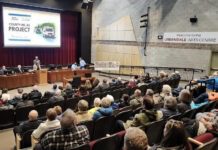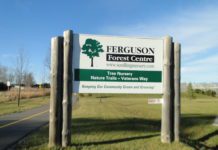by Fred Schueler & Aleta Karstad – submitted by Fragile Inheritance Natural History
In accord with the global student strike against climate inaction, and since nothing else seemed to be planned locally, we held a “Climate Change Flash Outdoor Seminar” at the parking lot beside the Oxford Mills dam from 12h00-13h00, 15 March.
Since overnight social media hadn’t attracted much of a crowd, we watched interactions between pairs and singletons of Crows, did the usual husband and wife thing of promising each other we wouldn’t do anything in our investigations of the creek which would predispose either of us towards drowning, and rehearsed our plans for dealing with climate change.
We had first compiled these plans in verse at Tlell, Haida Gwaii, in April & May 1989, under a title borrowed from a contemporary article in Scientific American:
“Evidence suggests that production of carbon dioxide and methane from human activities has already begun to change the climate, and that radical steps must be taken to halt any further change.”
Since those days, most of the discussion about combating climate change has been about reducing emissions from human activities. However, the other side of the campaign, as emphasized in our 1989 proposal, is scientifically known, but not broadly spoken of or applied. It recommends a global “carbon sequestration” policy of protecting and increasing biological communities which absorb carbon out of the atmosphere and deposit it into the organic soils beneath themselves. The Little Ice Age (1650-1850) is now thought to have been brought on by the regrowth of forests following the decimation of American nations by European conquest and diseases – so we have that example, and the challenge of replicating it without killing each other off.
Many proposals have been made towards this end on a global scale, ranging from massive reforestation to spreading iron salts in the high seas to trigger the growth of planktonic algae so the carbon they collect would sink to the ocean floor. But in this list we have restricted ourselves to carbon-sequestration activities possible for North Grenville:
- increase the area of peatlands & other wetlands, raising their outlet sills 1 cm/year to promote the formation of organic soils & peat
- replace lawns not needed for open-space human activity with stands of trees, favouring depleted native species
- bias agricultural tillage towards practices that increase soil organic matter manage roadsides, right-of-ways, and other open areas for deep-rooted native tall-grass prairie plants
- direct runoff as much as possible into terrestrial & wetland communities, where the nutrients in drainage will grow biomass, rather than letting them into streams & lakes where they are pollutants
- manage forests to promote characteristics of “oldgrowth”: large trees, coarse woody debris, organic soils, and a diverse community of forest-floor herbs and fungi
Some of these actions can be taken by individuals on their own land, while others will require various kinds of co-operation and co-ordination with municipalities, the Counties, the county forest, schools, and higher levels of government.
Anyone interested in further information, discussion, and working towards these goals is invited to contact Fred at bckcdb@istar.ca.





